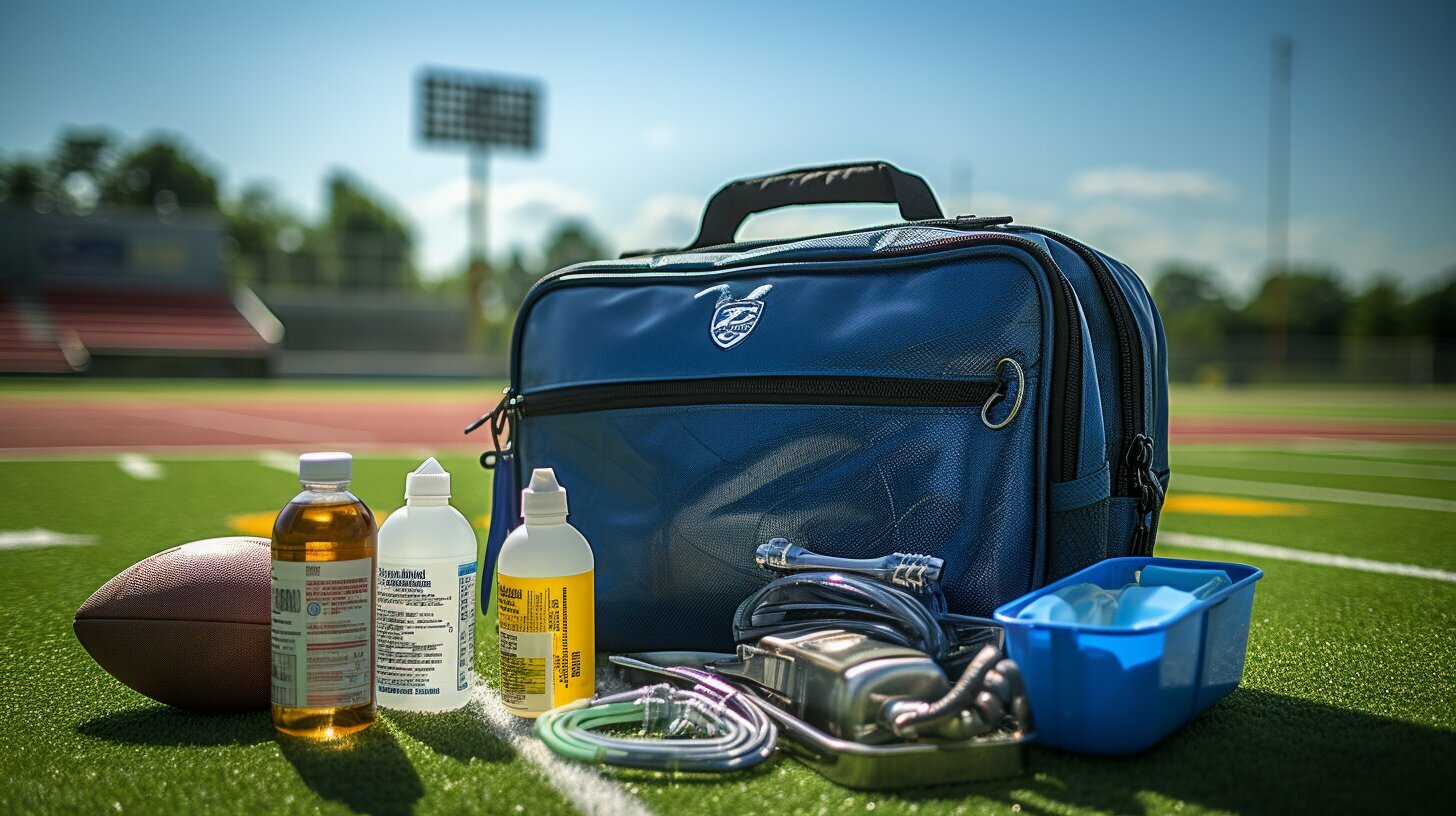In the world of football, ensuring player safety and well-being is of utmost importance, which is why it is crucial to prioritize hydration and include heat-related items in a football first aid kit. Proper hydration is essential for football players to perform at their best and prevent heat-related injuries.
USA Football recommends that athletes hydrate with 16-24 ounces of water or a sports drink before exercise and have unlimited access to water during physical activity. It’s vital for players to consume enough fluids to replace what is lost through sweat and maintain proper hydration levels. Football players should have as much water as they want and access to sports drinks for intense or prolonged exercise in the heat.
In addition to hydration, it’s important for coaches and parents to understand the signs and causes of heat illness. Heat-related illnesses can range from mild conditions like heat cramps to more severe ones like heat stroke. Heat acclimatization, which gradually exposes players to increased heat levels, can help their bodies adapt and cope better with the challenges of playing in high temperatures.
If any signs of heat-related illness are present, immediate first aid measures should be taken. This includes moving the affected individual to a cooler area and using active cooling techniques such as immersing them in cold water or applying ice or cold wet towels to their body. If necessary, medical help should be called to ensure prompt and appropriate treatment.
By prioritizing hydration and including heat-related items in a football first aid kit, coaches, parents, and players can take proactive steps to prevent heat-related injuries and ensure the safety and well-being of everyone involved in the game.
The Essential Role of Hydration in Football
Hydration is a vital component of a football player’s overall well-being, as proper fluid intake is essential to ensure optimal performance on the field and prevent the onset of dehydration. Athletes engage in intense physical activity during football games and practices, causing them to sweat and lose valuable fluids. Therefore, it is crucial for football players to maintain proper hydration levels throughout their training sessions and matches.
To prevent dehydration, USA Football recommends that athletes hydrate with 16-24 ounces of water or a sports drink before exercise. During exercise, players should have unlimited access to water and be able to drink as much as they want. For intense or prolonged exercise in the heat, it is advisable to provide sports drinks that contain electrolytes to replenish the body’s sodium and potassium levels and aid in hydration.
Recognizing the signs of dehydration is equally important. Coaches and parents should be vigilant in observing athletes for symptoms such as excessive thirst, fatigue, dizziness, or decreased performance. Heat-related illnesses can also occur if athletes do not acclimatize to high temperatures. It is recommended to gradually expose athletes to increased heat levels during training to help their bodies adapt and cope with the challenges that may arise during games and practices in hot weather.
In the event of a heat-related illness, prompt first aid is crucial. Athletes should be immediately moved to a cooler area and actively cooled by immersing them in cold water or applying ice or cold wet towels to their bodies. Medical help should be sought if necessary. By prioritizing hydration and taking immediate action when needed, football players can stay safe, perform at their best, and enjoy the game they love.
| Signs of Dehydration | Preventing Dehydration |
|---|---|
| Excessive thirst | Hydrate before, during, and after exercise |
| Fatigue | Provide unlimited access to water |
| Dizziness | Offer sports drinks with electrolytes for intense exercise |
| Decreased performance | Gradually expose athletes to heat during training |
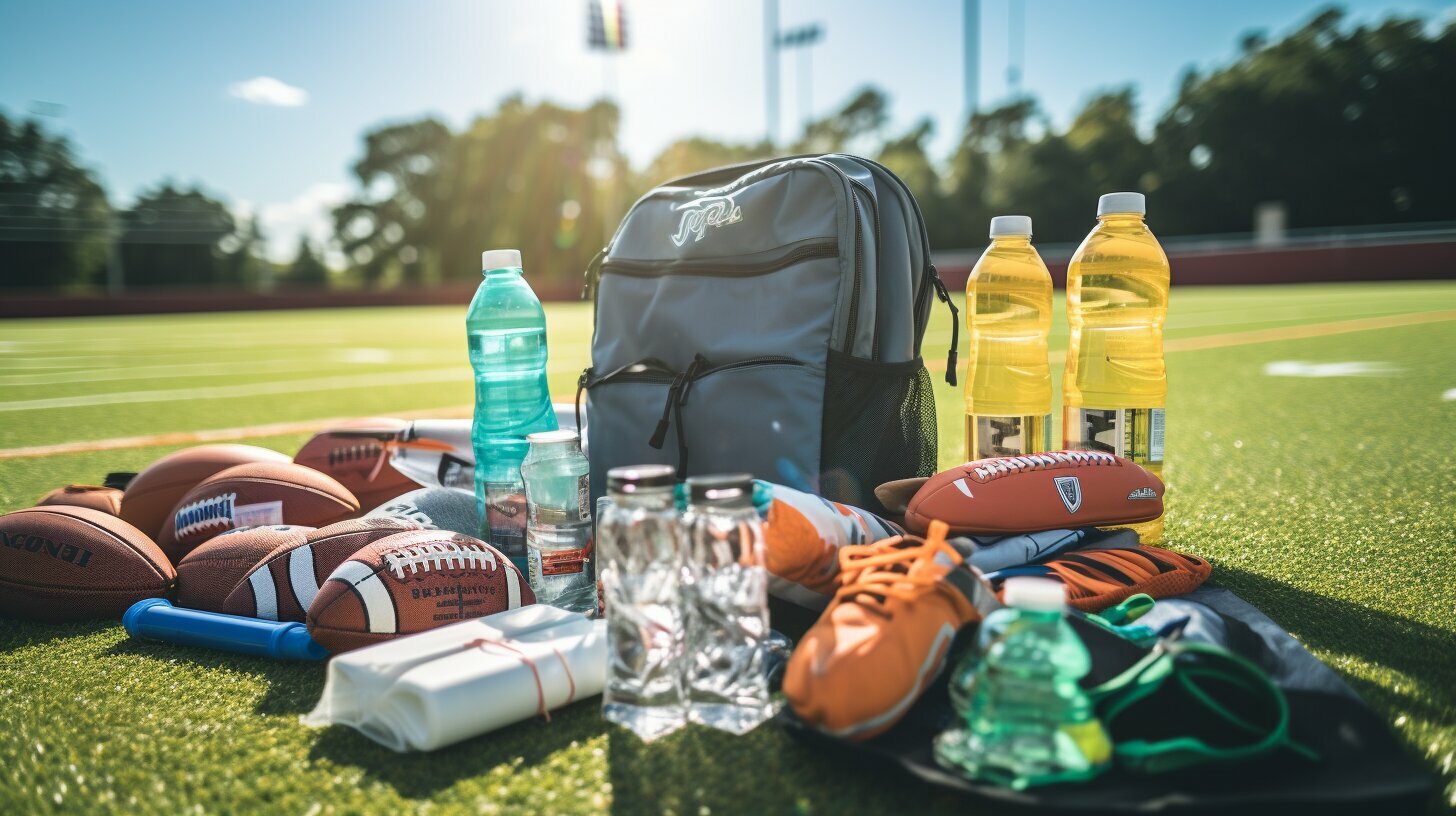
When engaging in strenuous physical activity like football, it is crucial to prioritize heat safety to prevent heat-related illnesses that can pose serious risks to the well-being of players. High-intensity workouts and exposure to excessive heat can lead to dehydration, heat exhaustion, and even heat stroke. To safeguard the health of football players, coaches, parents, and healthcare professionals must implement preventive measures to minimize the risk of heat-related incidents on the field.
One essential aspect of heat safety is proper hydration. Athletes should drink plenty of fluids before, during, and after exercise to maintain optimal performance and prevent dehydration. USA Football recommends that football players hydrate with 16-24 ounces of water or a sports drink before exercise and have unlimited access to water during activity. In particular, athletes engaged in intense or prolonged exercise in the heat should have the option to replenish electrolytes and fluids with sports drinks. By ensuring athletes have adequate access to hydration, coaches and parents can help mitigate the risk of heat-related illnesses.
Additionally, it is crucial to educate individuals involved in football about the signs and causes of heat illnesses. Heat exhaustion and heat stroke can manifest in symptoms such as excessive sweating, dizziness, nausea, confusion, and even loss of consciousness. Recognizing these warning signs is essential for the early identification of heat-related issues, enabling prompt intervention. Alongside this, athletes should undergo a period of heat acclimatization, gradually exposing their bodies to increased heat levels during practices and conditioning sessions. This process prepares athletes’ bodies to better cope with the challenges posed by high temperatures during games and practices, reducing the risk of heat-related incidents.
| Signs of Heat Illness | Causes of Heat Illness |
|---|---|
|
|
In the unfortunate event of a heat-related emergency on the football field, prompt first aid is crucial. Affected individuals should be immediately moved to a cooler area. Active cooling techniques, such as immersion in cold water or the application of ice or cold wet towels to the body, should be employed to lower body temperature. It is essential to call for medical help if the individual’s condition does not improve or worsens. By taking swift and appropriate action, coaches and first aid responders can minimize the potential long-term consequences of heat-related illnesses.

Overall, ensuring heat safety in football is vital for the well-being of players. By prioritizing hydration, recognizing the signs and causes of heat illness, implementing heat acclimatization protocols, and providing prompt first aid, coaches and parents can protect athletes from the risks associated with excessive heat exposure. By taking these proactive measures, everyone involved can contribute to creating a safe and healthy environment for football players.
Identifying Heat-Related Signs and Causes
Recognizing the early signs of heat-related illnesses is key to prompt intervention and preventing more severe complications that can arise from prolonged exposure to high temperatures during football activities. It is essential for coaches, parents, and athletes themselves to be aware of these signs and take appropriate action.
One common heat-related illness in football is heat exhaustion. Symptoms of heat exhaustion include excessive sweating, dizziness, fatigue, nausea, headache, and muscle cramps. If any of these signs are observed in a player, immediate measures should be taken to cool them down and provide fluids.
Another more severe heat-related condition is heat stroke, which is a medical emergency. Heat stroke occurs when the body’s temperature regulation system fails, and the body temperature rises to dangerous levels. Symptoms of heat stroke include high body temperature, altered mental state, confusion, rapid breathing, and a rapid heartbeat. Immediate medical attention should be sought if heat stroke is suspected.
There are several factors that can contribute to heat-related illnesses in football. These include high temperatures and humidity, inadequate hydration, lack of appropriate breaks and rest periods, improper equipment, and insufficient acclimatization to the heat. Understanding these causes can help in implementing preventive measures and promoting player safety.
| Heat-Related Signs | Heat-Related Causes |
|---|---|
|
|
By being aware of the signs and causes of heat-related illnesses, coaches and parents can play a proactive role in preventing and managing these conditions. Providing proper hydration, implementing appropriate rest breaks, ensuring players have access to adequate shade, and gradually acclimatizing them to the heat are all crucial steps in ensuring the safety and well-being of football players.
Essential Heat-Related Items for Football First Aid Kits
Equipping a football first aid kit with essential heat-related items ensures that appropriate care is readily available in case of any heat-related emergencies during the game or practice sessions. These items help provide immediate relief and aid in managing heat-related incidents on the field. Here are some key heat-related items that every football first aid kit should contain:
1. Cold Packs or Instant Ice Packs
Cold packs or instant ice packs are essential for providing immediate cooling to athletes experiencing heat-related distress. These packs can quickly lower body temperature and alleviate discomfort. They should be easily accessible and stored properly to ensure their effectiveness when needed.
2. Cooling Towels
Cooling towels are specially designed to provide instant relief from heat by absorbing sweat and reducing body temperature. These towels are made from high-quality, moisture-wicking fabric that retains water for longer cooling periods. They are lightweight, portable, and easy to use, making them ideal for athletes during intense physical activity in the heat.
3. Electrolyte Solutions or Sports Drinks
Electrolyte solutions or sports drinks play a vital role in replenishing essential nutrients and electrolytes lost through sweating. These beverages help maintain hydration levels and restore the body’s electrolyte balance. It is important to include a variety of electrolyte solutions or sports drinks to cater to different taste preferences and ensure athletes have access to the fluids they need to stay hydrated.
4. Sunscreen
Protecting the skin from harmful UV rays is crucial during outdoor sports activities, especially in hot weather. Including a sunscreen with a high sun protection factor (SPF) in the first aid kit ensures that athletes can apply it before heading onto the field. This helps prevent sunburn and reduces the risk of long-term sun damage.
Equipping a football first aid kit with these essential heat-related items demonstrates a commitment to player safety and well-being. These items not only aid in immediate care but also promote preventive measures to minimize the risk of heat-related illnesses. By being prepared and proactive, coaches, parents, and athletes can enjoy the game while prioritizing the health and safety of everyone involved.
| Item | Description |
|---|---|
| Cold Packs or Instant Ice Packs | These packs quickly lower body temperature and provide immediate cooling. |
| Cooling Towels | These towels absorb sweat and reduce body temperature, providing instant relief from heat. |
| Electrolyte Solutions or Sports Drinks | These beverages replenish essential nutrients and electrolytes lost through sweating. |
| Sunscreen | A high SPF sunscreen protects the skin from harmful UV rays during outdoor activities. |
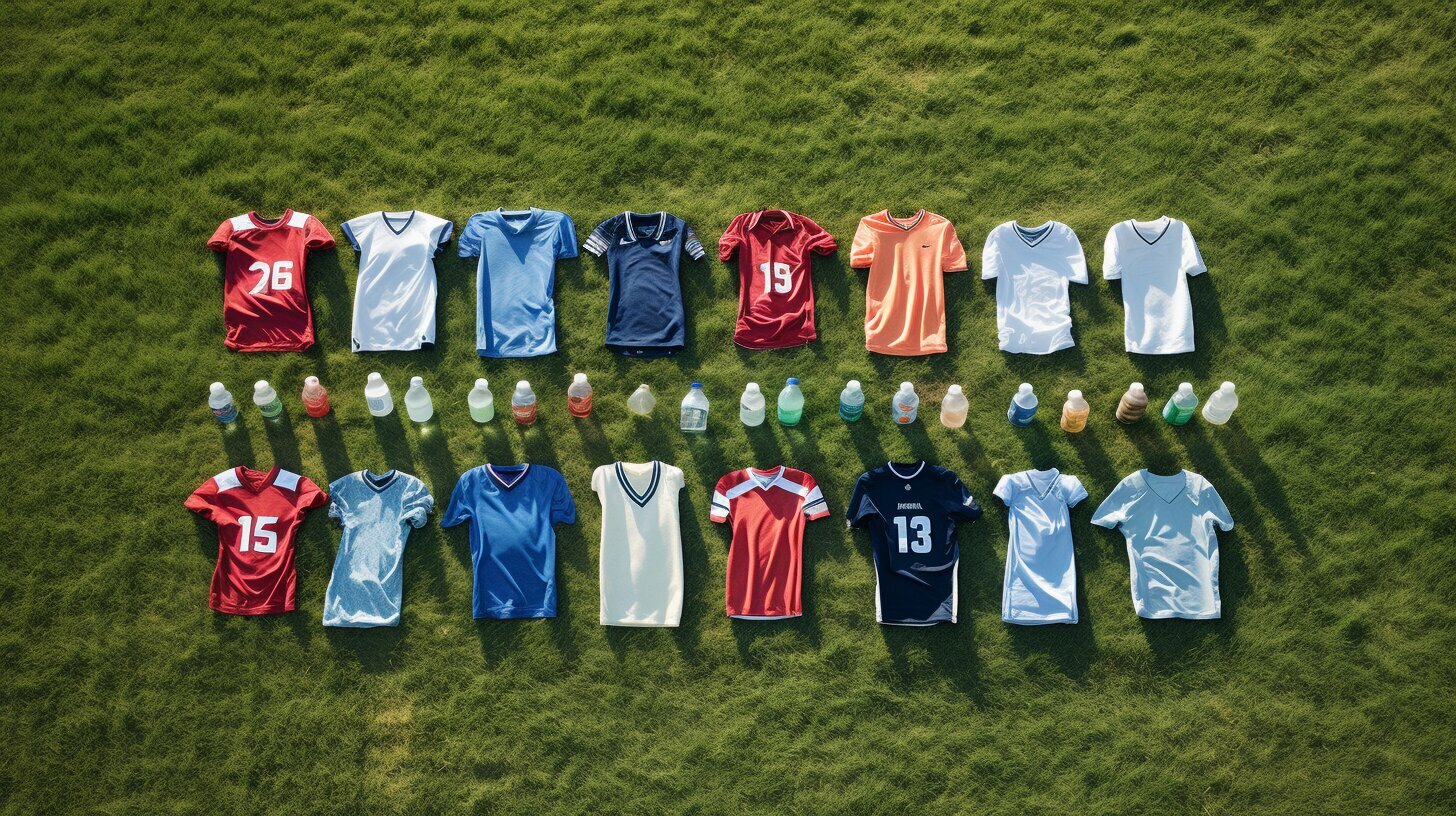
Implementing effective hydration strategies that encompass pre, intra, and post-exercise periods is crucial for football players to stay adequately hydrated and perform at their best on the field. Proper hydration not only helps athletes maintain optimal physical performance but also prevents the risk of dehydration and heat-related illnesses.
Before exercise, it is important for athletes to hydrate well in advance. USA Football recommends consuming 16-24 ounces of water or a sports drink at least 2 hours before physical activity. This allows sufficient time for the body to absorb and distribute the fluids, ensuring proper hydration levels are maintained.
During exercise, athletes should have unlimited access to water and be encouraged to drink as much as they want. If the activity is intense or prolonged, sports drinks can be beneficial as they provide essential electrolytes and carbohydrates to replenish energy levels and maintain hydration. Having water breaks at regular intervals during practice and games is essential to prevent dehydration.
After exercise, athletes should continue to hydrate to replace any fluids lost through sweat. Drinking water or sports drinks within 30 minutes of physical activity helps replenish the body’s electrolyte balance and aids in muscle recovery. It is also recommended to consume snacks or meals that contain both carbohydrates and protein to further support recovery.
Hydration Strategies Before, During, and After Exercise
| Hydration Period | Recommendation |
|---|---|
| Pre-exercise | Consume 16-24 ounces of water or a sports drink at least 2 hours before physical activity. |
| Intra-exercise | Drink water or sports drinks as desired. Have regular water breaks during intense or prolonged activity. |
| Post-exercise | Drink water or sports drinks within 30 minutes of physical activity. Consume snacks or meals with carbohydrates and protein. |
By following these hydration strategies before, during, and after exercise, football players can ensure that they remain properly hydrated and equipped for optimal performance on the field. Coaches and parents play a vital role in educating athletes about the importance of hydration and providing access to fluids during practice and games. Remember, a well-hydrated athlete is a healthy and high-performing athlete.

Heat acclimatization and training play a crucial role in preparing football players to perform optimally in hot and humid conditions, reducing the risk of heat-related illnesses and injury. It is essential for athletes to gradually expose themselves to higher heat levels, allowing their bodies to adapt and become more efficient in dealing with the challenges posed by extreme temperatures on the field.
During the acclimatization process, athletes typically undergo a series of training sessions in progressively increasing heat conditions. This allows their bodies to adjust to the demands of performing in a high-temperature environment. The duration and intensity of these training sessions may vary depending on individual needs and environmental factors.
By gradually increasing exposure to heat, athletes can experience physiological adaptations that improve their ability to dissipate heat and maintain proper temperature regulation. These adaptations include increased sweat production, earlier onset of sweating, reduced sodium losses, and improved cardiovascular function.
Moreover, heat acclimatization helps athletes recognize their personal limits and become more aware of the signs and symptoms of heat illness. This knowledge enables them to take appropriate preventive measures, such as staying hydrated, seeking shade during breaks, and wearing appropriate clothing. Coaches and parents need to closely monitor athletes during the acclimatization process and ensure that safety measures are in place to protect their well-being.
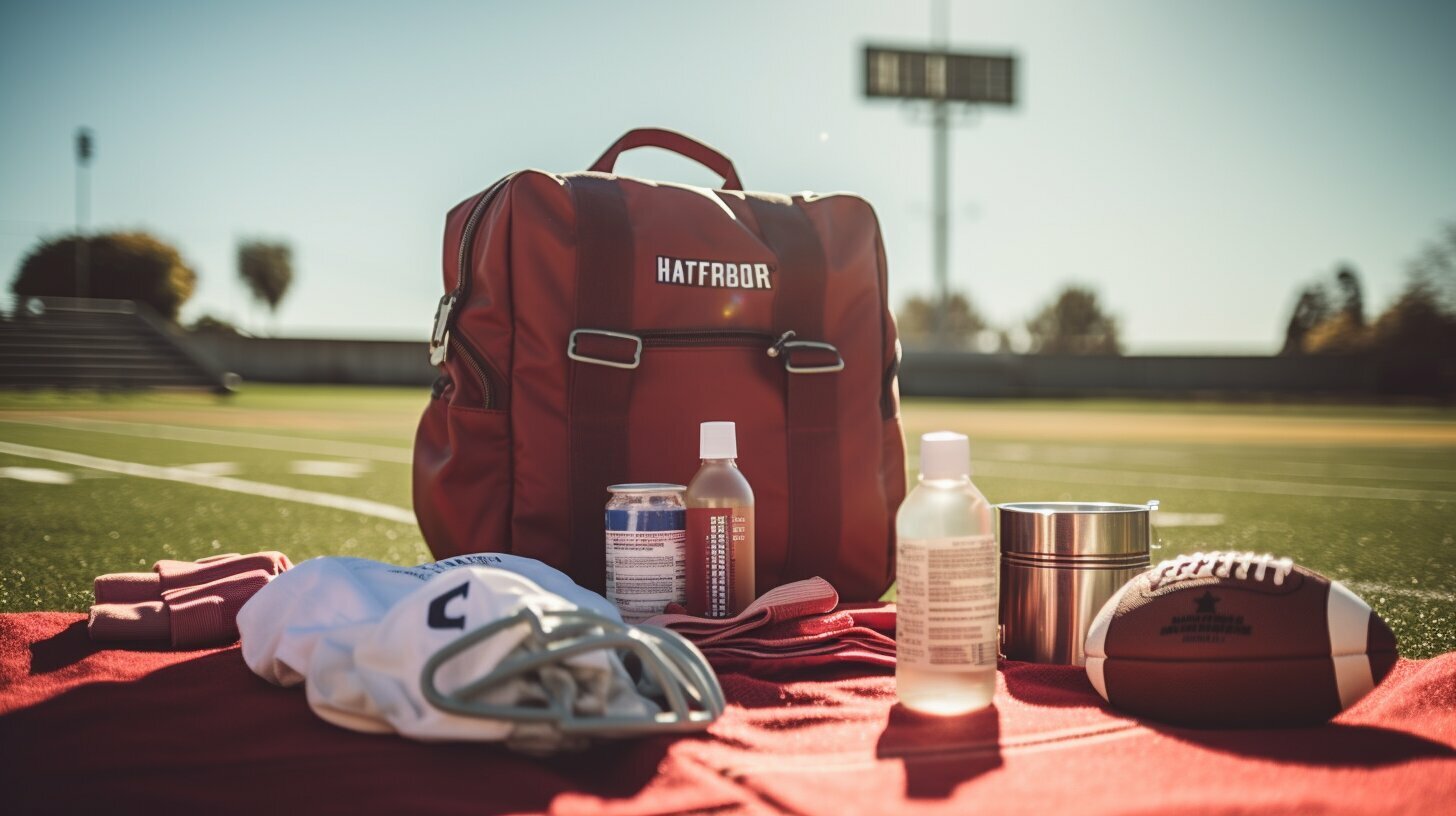
| Heat Acclimatization Guidelines |
|---|
| Gradually increase training duration and intensity in the heat over a period of 7-14 days |
| Make sure athletes have access to water and encourage frequent hydration breaks |
| Monitor athletes closely for signs of heat illness and provide immediate care if necessary |
| Provide shaded areas or allow for rest breaks in cooler environments |
| Educate athletes about the importance of proper hydration and the signs and symptoms of heat illness |
By incorporating heat acclimatization and training into their preparation, football players can enhance their performance, reduce the risk of heat-related illnesses, and ensure a safer playing environment. The combination of proper hydration, heat acclimatization, and preventive measures is vital for the overall well-being and success of athletes.
Prompt First Aid for Heat-Related Emergencies
Acting swiftly and appropriately in response to heat-related emergencies is essential to prevent further complications and ensure the well-being of football players in distress. When faced with a heat-related incident on the field, it is crucial to follow proper first aid protocols to provide immediate relief and aid in the recovery process.
As a first step, move the individual to a cooler area away from direct sunlight. This will help reduce their exposure to excessive heat and allow for a more comfortable environment for treatment. Once in a cooler area, it is important to actively cool the affected individual using appropriate techniques.
One effective method is to immerse the person in cold water if it is readily available. This can help lower their body temperature and provide immediate relief. If immersing in water is not possible, apply ice packs or cold wet towels to the body to help cool them down. Focus on areas such as the neck, armpits, and groin, as these areas have a higher concentration of blood vessels and can aid in faster cooling.
| Signs of Heat-Related Illness | Causes of Heat-Related Illness |
|---|---|
| Headache | Excessive heat exposure |
| Dizziness | Inadequate hydration |
| Nausea or vomiting | Poor acclimatization to the heat |
| Muscle cramps | Intense physical activity |
| Fainting or loss of consciousness | Prolonged exposure to high temperatures |
If the individual’s condition does not improve or if their symptoms worsen, it is important to seek immediate medical help. Heat-related emergencies can be serious, and professional medical attention may be necessary to ensure proper treatment and recovery.
By being prepared and knowledgeable about prompt first aid measures for heat-related emergencies, coaches, parents, and other individuals involved in football can play a crucial role in safeguarding the health and well-being of players. Remember, quick and appropriate action can be the difference between a minor incident and a potentially life-threatening situation.
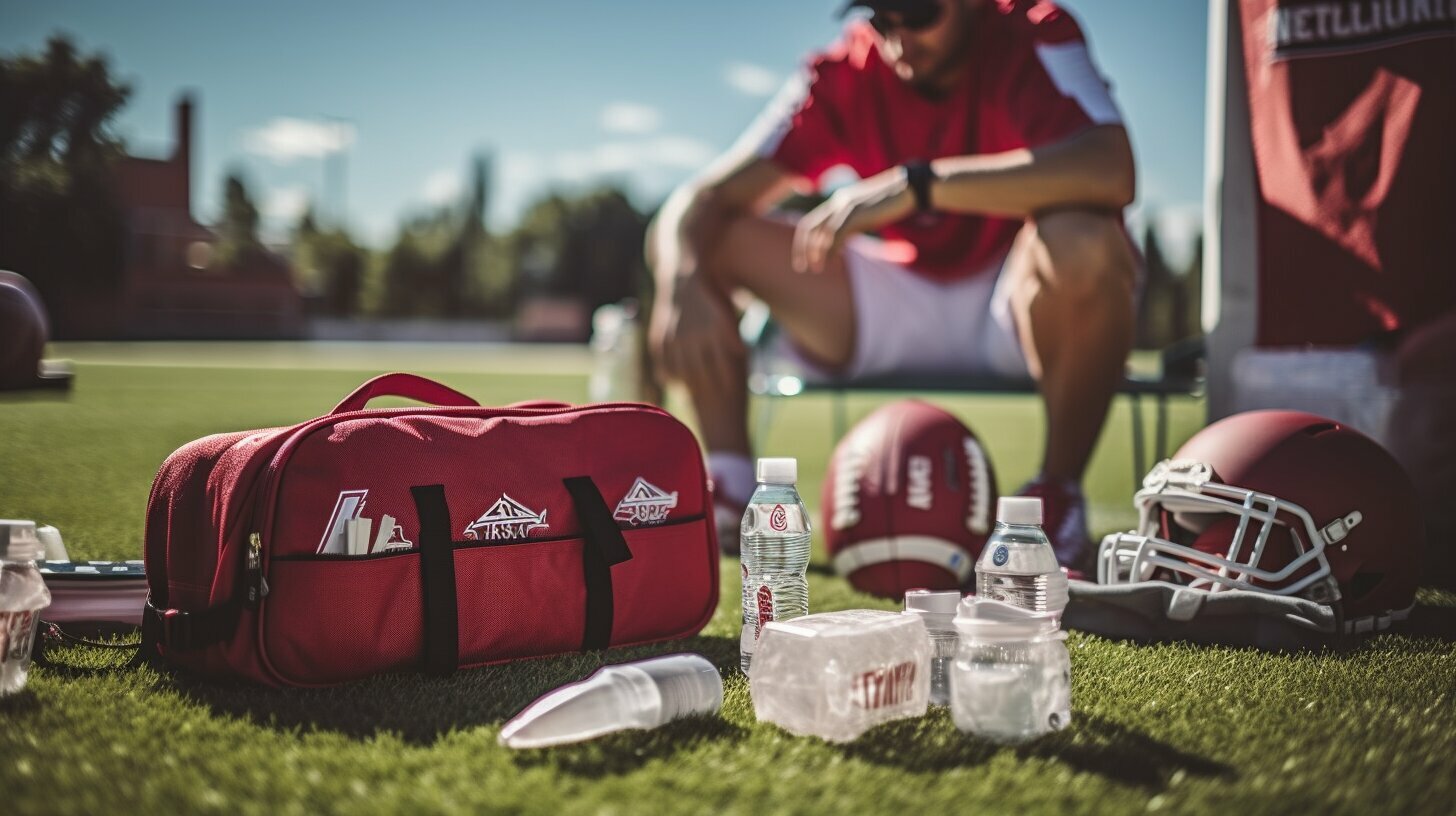
Prioritizing hydration and including heat-related items in a football first aid kit are fundamental steps towards safeguarding the health and performance of football players, allowing them to enjoy the game while minimizing the risks associated with heat-related incidents.
Factual data supports the importance of hydration in football. USA Football recommends athletes to hydrate with 16-24 ounces of water or sports drinks before exercise and have unlimited access to water during exercise. Providing athletes with the ability to drink as much as they need and access to sports drinks for intense or prolonged exercise in the heat is vital.
Recognizing the signs and causes of heat illness is crucial. Coaches and parents should ensure athletes drink plenty of water and take immediate action if any signs of heat-related illness arise. Additionally, athletes should undergo a period of heat acclimatization to help their bodies adapt to high temperatures.
Prompt first aid is essential in heat-related emergencies. Affected individuals should be moved to a cooler area and actively cooled using techniques such as immersion in cold water or applying ice or cold wet towels to the body. Seeking medical help if necessary is also crucial.
